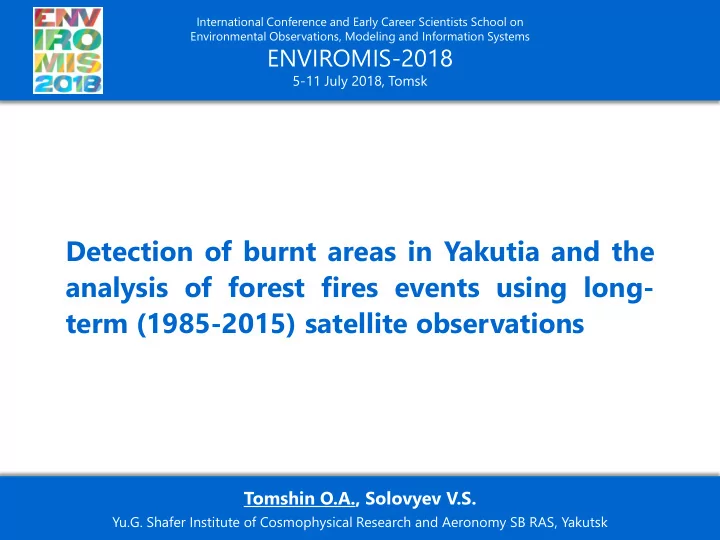

International Conference and Early Career Scientists School on Environmental Observations, Modeling and Information Systems ENVIROMIS-2018 5-11 July 2018, Tomsk Detection of burnt areas in Yakutia and the analysis of forest fires events using long- term (1985-2015) satellite observations Tomshin О.А. , Solovyev V.S. Yu.G. Shafer Institute of Cosmophysical Research and Aeronomy SB RAS, Yakutsk
Motivation Forest fires: • Cause severe damage to forest ecosystems • Pollute the atmosphere with combustion products • Reduce earth's surface albedo and affect the temperature regime of soils Climate change can affect forest fires regime. Available satellite estimates of the burnt areas cover the period 2001- 2017 (MODIS). The aim is to map the burnt areas in Yakutia with satellite observations data (AVHRR) for the period 1985- 2015. 2
Data and Methods Data: MODIS (Terra/Aqua) → Burned Area MCD45 (500m) – 2001-2015 • AVHRR (NOAA) → NDVI (0.08 ° ), LAC images (1km) – 1985-2015 • Burned area mapping algorithm 𝑶𝑬𝑾𝑱 = 𝑶𝑱𝑺 − 𝑾𝑱𝑻 NDVI for T and T-1 𝑶𝑱𝑺 + 𝑾𝑱𝑻 season NearIR (NIR) — albedo in near infrared spectral region VIS — albedo in visual spectral region Algorithmic detection of burned areas Final evaluation by NOAA-18 14.08.2011 NOAA-19 08.08.2012 expert assessment 3
Data and Methods Verification with multispectral images and active fire’s hotspots 4
Comparison with MODIS Final product after MODIS Product expert evaluation RGB image Algorithm Sept. 2012 results 5
Comparison with MODIS MODIS and AVHRR Burned Areas 2001-2015 2,5 3,0 R=0,97 Burned area, × 10 6 ha 2,0 MODIS, × 10 6 ha 2,0 1,5 1,0 1,0 0,5 y = 1,0142x - 0,005 R² = 0,9421 0,0 0,0 2001 2003 2005 2007 2009 2011 2013 2015 0,0 0,5 1,0 1,5 2,0 2,5 AVHRR, × 10 6 ha MODIS AVHRR 6
Results Burned areas per 1000 ha, AVHRR AVHRR Burned areas 1985-2015 1985-2015 2,5 Burned areas, × 10 6 ha 2,0 1,5 1,0 0,5 0,0 1985 1990 1995 2000 2005 2010 2015 7
Emissions E = A B C D А – burned area [m2]; B – density of the burned biomass [kg/m2]; C – proportion of biomass burned [%]; D – mass of the material ejected from the combustion of 1 kg of biomass [g/kg]; E – total emission. * Seiler W., Crutzen P. J. Estimates of gross and net fluxes of carbon between the biosphere and atmosphere from biomass burning // Climate Change. 1980. V. 2. P. 207-247. 10 CO 2 × 10 13 , PM 10 × 10 11 , BC CO2 PM10 BC 8 6 × 10 10 , g 4 2 0 1985 1990 1995 2000 2005 2010 2015 8
Summary • The algorithm for detecting the burned areas by comparison of inter- seasonal changes of NDVI was developed and adapted to the conditions of forest fires in Yakutia (Eastern Siberia). • The results of fire scars detection with the adapted algorithm showed good agreement with the MODIS data (2001-2015), R=0.97, which justifies the use of the algorithm for the entire AVHRR data set. • The summary map of the forest fire in Yakutia, plotted according to AVHRR (1985-2015), shows the presence of two regions in central Yakutia with higher forest burning ratio (Leno-Vilyui interfluve and along the coast of Aldan). 9
Recommend
More recommend